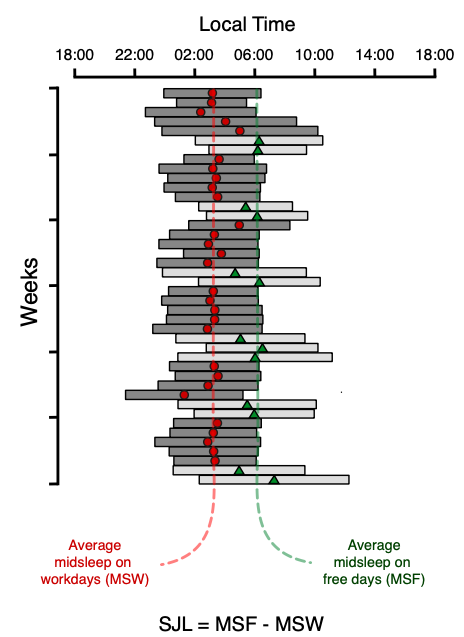*Geek Box: Chronotype & Social Jetlag
To grasp these concepts a bit more, let’s dig into two distinct, but highly related, concepts: your ‘chronotype’ and ‘social jetlag’. Your “chronotype” (essentially meaning ‘time type’) is a behavioural representation of your internal biological ‘clock’ timing. It is important to note that a chronotype is a biological construct, not a psychological construct or trait.
Our current scientific understanding shows a strong genetic influence on this time of day preference. This genetic foundation interacts with our modern environment – artificial light, work schedules, trans-meridian air travel, social life timing – to influence our behavioural preferences for morning or evening. Think of it this way: we are all exposed to the same light-dark cycle in a given time zone, but the timing of our internal biological processes will synchronise to this external time with different phases.
For example, I might have a desired sleep phase from 9pm to 5am, while you might prefer to sleep from midnight to 8am. To determine our chronotypes, we would calculate the midpoint of sleep. In this example, my midpoint of sleep would be 1am and yours would be 4am. In this example, I have an earlier sleep phase, and would also likely feel most alert and active earlier in the day, while you would have a later sleep phase and would feel most alert and active in the evening or at night.
But let’s say we both have to be up at 6am on workdays. This is fine for me; but this is cutting your sleep short by 2hrs. The research shows that late chronotypes do not compensate by going to bed earlier, so the effect is that having to wake up earlier results in curtailed sleep. As a result, late chronotypes accumulate sleep debt during the working week. This is where social jetlag comes in.
As highlighted above, social jetlag arises when our sleep-wake timing on workdays is different to our preferred sleep-wake timing. Check out the graph below: you can see the dark grey bars represent workdays, with red dots showing the midpoint of sleep on workdays. The light grey bars represent free days, when people can sleep according to personal preference, with the green triangles being the midpoint of sleep on free days. Social jetlag is calculated by subtracting the midpoint of sleep on workdays from that on free days, i.e., the difference between the two, and is expressed in hours:minutes. The difference between social jetlag and jetlag from air travel, is that you eventually adjust to your new time zone with air travel; with social jetlag, it is chronic, occurring week after week over time.

Figure from Roenneberg et al. (3).
